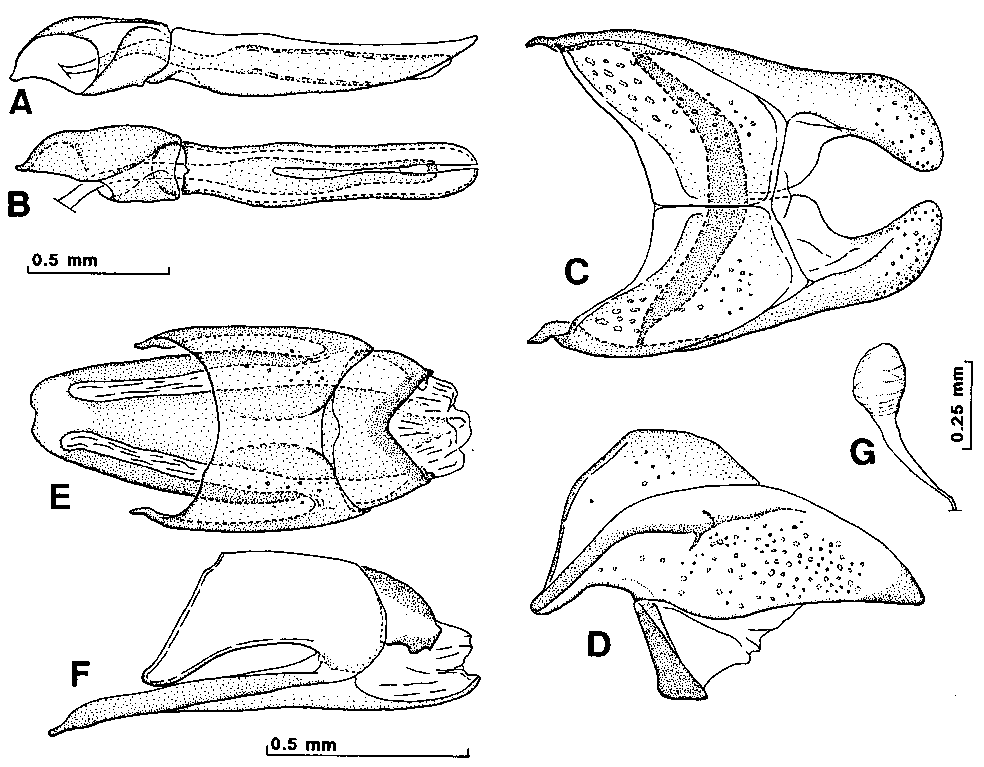Sphaerites glabratus Fabricius, 1792
Sphaerites politus: Ohara, 1994, 58, misidentification.
Sphaerites glabratus: Lobl, 1996, 199; Ohara, 1996, 9.
Spaerites politus Mannerheim, 1846: 514; Kryzhanovskij and
Reichardt, 1976: 22; Adachi and Ohno, 1962: 149; Nakane, 1963:
67, pl. 34, no. 1; Matsumoto, 1981: 6 [Mt. Hidaka]; Yasuda, 1982:
76 [Mt. Daisetsu]; Hisamatsu, 1985: 219, pl. 40, no. 1; Yasuda,
1988: 25.
Japanese name: Emma-mushi-damashi.

Ohara (1994)
Description. Body length, PPL, 4.56 - 5.63 mm (5.14
± 0.12, n=9), PEL, 4.38 - 5.31 mm (4.99 ± 0.10,
n=9). Width, 2.94 - 3.56 mm (3.28 ± 0.07, n=9). Body oblong
(Fig. 37A). Cuticle shining and bronze; tarsi and antennae dark
rufopiceous. Biometric data are given in Table 4.
Anterior margin of head narrowly marginate laterally between
basal corner of epistoma and eye just behind antennal cavity.
Surface of head coarsely and densely punctate, the punctures becoming
finer and sparser on central area and epistoma.
Anterior margin of pronotum (Fig. 37A) evenly emarginate; lateral
sides weakly arcuate on apical half, and nearly straight on basal
half; posterior margin strongly arcuate outwards in median third;
marginal stria complete laterally, its apical end curved behind
apical corner, extended inwards, and attaining to near the lateral
third of pronotum, the stria somewhat distantly present from the
pronotal margin; surface sparsely and coarsely punctate laterally,
and with other fine punctures intermingled, the fine punctures
progressively finer inwardly; on median area of the surface clothed
with microscopic punctures.
Epipleura narrow. Marginal epipleural stria complete and carinate.
Marginal elytral stria strongly carinate and complete. Area between
the margin of epipleura and the marginal elytral stria shining
and sparsely clothed with several microscopic punctures. Elytra
(Fig. 37A) with 10 rows which are nearly complete and consist
of coarse and round serial punctures, which are separated by their
own diameter to twice the diameter but irregularly scattered on
apical sixth; intervals among the rows sparsely clothed with microscopic
punctures.
Pygidium (Fig. 37B) with marginal stria along lateroposterior
margin, the basal end not attaining to the basal corner, curved
before the corner and shortly extended inwards; surface of disk
densely covered with coarse punctures which are a little coarser
than in elytral rows; other fine punctures intermingled among
them, becoming sparser apically.
Antennal grooves present on apical area of underside of head,
the grooves running obliquely from apex of eyes to middle of head.
Anterior margin of prosternum evenly emarginate, and with long
hairs; median area of disk densely covered with coarse setiferous
punctures, the setae being somewhat long.
Mesosternum small and quadrangular, its disk densely covered
with coarse punctures. Meso-metasternal suture distinctly present.
Anterior margin of metasternum behind mesocoxae strongly carinate
and marginate; intercoxal disk sparsely covered with fine punctures,
the punctures becoming coarser laterally; lateral disk sparsely
covered with large, round and shallow punctures. Metepisternum
densely punctate, the punctures as large as those of lateral disk
of metasternum; on area along the posterior margin transverse
stria present, but broadly interrupted on median third, the median
end of the stria densely with coarse punctures.
Protibia (Fig. 37D, C) slender, not expanded, usually with
7 denticles on outer margin.
Male genitalia as shown in Fig. 38A - F.
Female genitalia: spermatheca as shown in Fig. 38G.

Remarks. Sphaerites politus can rather easily be recognized
by the characters given in the key to the families.
Little is known about the habitat of this species. This species
occurs at high altitudes. Yasuda (1982, 1988) collected it by
using pit-fall traps in the forest of Pinus pumila at alt. 1800
m to 1980 m on Mt. Kurodake, Daisetsu, Hokkaidô.
Table 4. Biometric data of Sphaerites politus Mannerheim.
-----------------------------------------------------------------------
APW 1.31-1.63 (1.47±0.03) 9
PPW 2.38-2.81 (2.65±0.05) 9
PL 1.25-1.56 (1.48±0.04) 9
EL 2.75-3.75 (3.41±0.09) 9
EW 2.94-3.56 (3.28±0.07) 9
PyW 1.63-2.00 (1.85±0.04) 9
PyL 0.88-1.25 (1.05±0.05) 9
PTL 1.13-1.50 (1.33±0.04) 9
MSTL 1.25-1.56 (1.35±0.03) 9
MTTL 1.50-1.94 (1.72±0.05) 9
-------------------------------------------------------------------------
Ohara (1994)
[Hokkaidô] 1Åâ3ÅäÅä,
1 ex., Mt. Kurodake (Alt. 1900m), Mt. Daisetsu, 18/vii/1981, N.
Yasuda leg. (NA); 7 exs., Ditto, 23/vii/1981, N. Yasuda leg.;
4 exs., Ditto, 28/vii/1982, N. Yasuda leg.; 2 exs., Akadake, 16-23/vii/1975,
M. Suwa, M. Furukawa, M. Kiuchi and T. Sunose leg. <Rishiri
Is.> 1 ex., Rishiri Is., 24/vii/1963, Y. Shibata leg. (NSMT);
1 ex., Oniwaki trail, Mt. Rishiri, 7/viii/1992, M. Satô
leg.
Remarks (Ohara, 1999a). Lobl (1996) revised
the genus Sphaerites from eastern Asia and identified Japanese
specimens with S. glabratus.
Distribution. Japan (Hokkaidô, Rishiri Is.), northern
part of the Palaearctic region.

Emmamushi.Home/Sphaeritidae/ Sphaeritus/References


